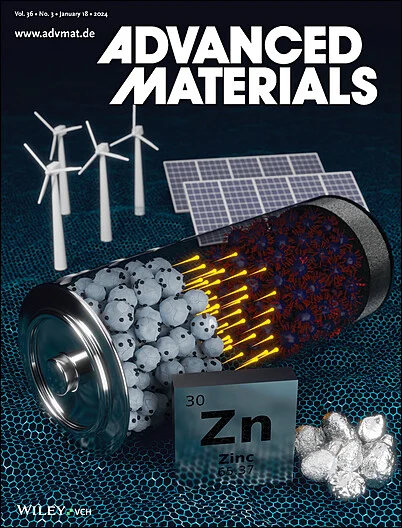Enhancing Oxygen Evolution Electrocatalysis in Heazlewoodite: Unveiling the Critical Role of Entropy Levels and Surface Reconstruction
IF 27.4
1区 材料科学
Q1 CHEMISTRY, MULTIDISCIPLINARY
引用次数: 0
Abstract
Entropy engineering has proven effective in enhancing catalyst electrochemical properties, particularly for the oxygen evolution reaction (OER). Challenges persist, however, in modulating entropy and understanding the dynamic reconfiguration of high-entropy sulfides during OER. In this study, an innovative in situ corrosion method is introduced to convert low-valent nickel on a nickel foam substrate into high-entropy heazlewoodite (HES/NF), significantly boosting OER performance. By synthesizing a series of low-, medium-, and high-entropy heazlewoodites, the intrinsic factors influence catalyst surface evolution and electrocatalytic activity is systematically explored. Employing a combination of in situ and ex situ characterization techniques, it is observed that HES/NF dynamically transforms into a stable hydroxide oxide (MOOH)-sulfide composite under OER conditions. This transition, coupled with lattice distortion, optimizes the electrostatic potential distribution, ensuring superior catalytic activity and preventing surface sulfide deactivation through the formation of stable HES-MOOH species. This synergy enables HES/NF to achieve remarkably low overpotentials: 172.0 mV at 100.0 mA cm−2 and 229.0 mV at an extreme current density of 300.0 mA cm−2. When paired with a Pt/C cathode, HES/NF exhibits rapid kinetics, outstanding stability, and exceptional water-splitting performance. The scalable, cost-effective approach paves the way for advanced electrocatalyst design, promising breakthroughs in energy storage and conversion technologies.

事实证明,熵工程可以有效提高催化剂的电化学性能,特别是氧进化反应(OER)的性能。然而,在调节熵和了解 OER 期间高熵硫化物的动态重构方面仍然存在挑战。本研究采用了一种创新的原位腐蚀方法,将泡沫镍基底上的低价镍转化为高熵沸石(HES/NF),从而显著提高了 OER 性能。通过合成一系列低、中、高熵沸石,系统地探讨了影响催化剂表面演化和电催化活性的内在因素。结合使用原位和非原位表征技术,观察到 HES/NF 在 OER 条件下动态转变为稳定的氢氧化物 (MOOH) - 硫化物复合体。这种转变与晶格畸变相结合,优化了静电位分布,确保了卓越的催化活性,并通过形成稳定的 HES-MOOH 物种防止表面硫化物失活。这种协同作用使 HES/NF 的过电位非常低:在 100.0 mA cm-2 时为 172.0 mV,在 300.0 mA cm-2 的极限电流密度下为 229.0 mV。与 Pt/C 阴极搭配使用时,HES/NF 表现出快速的动力学、出色的稳定性和卓越的水分离性能。这种可扩展、具有成本效益的方法为先进的电催化剂设计铺平了道路,有望在能量存储和转换技术方面取得突破。
本文章由计算机程序翻译,如有差异,请以英文原文为准。
求助全文
约1分钟内获得全文
求助全文
来源期刊

Advanced Materials
工程技术-材料科学:综合
CiteScore
43.00
自引率
4.10%
发文量
2182
审稿时长
2 months
期刊介绍:
Advanced Materials, one of the world's most prestigious journals and the foundation of the Advanced portfolio, is the home of choice for best-in-class materials science for more than 30 years. Following this fast-growing and interdisciplinary field, we are considering and publishing the most important discoveries on any and all materials from materials scientists, chemists, physicists, engineers as well as health and life scientists and bringing you the latest results and trends in modern materials-related research every week.
 求助内容:
求助内容: 应助结果提醒方式:
应助结果提醒方式:


